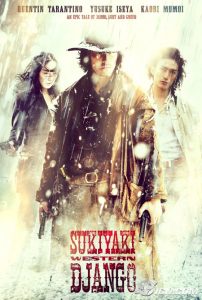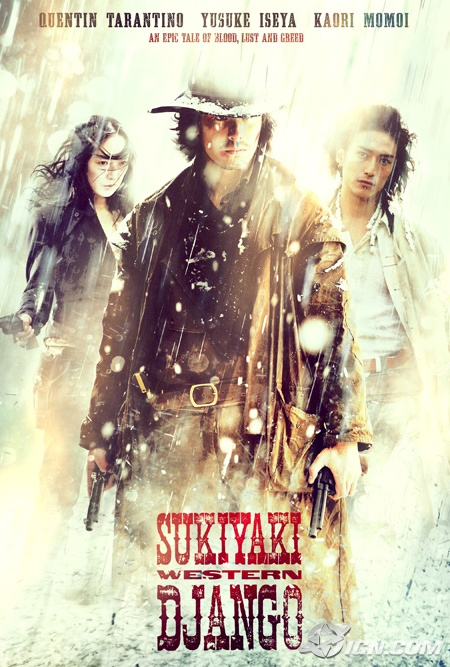by Chelsea Thornton (Staff Writer)
 Directed by Takashi Miike, Suki Yaki Western Django is a classic cowboy movie, in a not so-classic location. Instead of the American Southwest, the action takes place in small-town Japan. The plot line is pretty standard: a mysterious outsider arrives in town in search of riches, only to discover that two rival gangs have claimed the town.
Directed by Takashi Miike, Suki Yaki Western Django is a classic cowboy movie, in a not so-classic location. Instead of the American Southwest, the action takes place in small-town Japan. The plot line is pretty standard: a mysterious outsider arrives in town in search of riches, only to discover that two rival gangs have claimed the town.
The usual violence ensues. More cinematically aware minds than mine have accused the film of drawing on too many of its predecessors, generally lacking in any innovation or original thought. If, however, you are willing to shut away your critic’s eye for a couple of hours, Miike has actually provided a delightfully odd viewing experience. The movie is completely Japanese; the writers, director, actors and locations all hail from Japan – but the script is almost entirely English. And so begins the list of oddities that Suki Yaki Western Django can boast of.
From the opening scene, which takes place against a painted set like you would see in an elementary school play, to one gang leader’s obsession with Shakespeare, Miike keeps the viewer scratching their head throughout the entire movie. The oddities in the plot are matched by a slightly unreal visual landscape. The world of the story is largely gray, but the action takes place in vivid color. The two gangs, which differentiate themselves by wearing either red or white, stand out against the colorless background, as does the copious amount of blood they spill. The costumes are also surreal: a combination of eastern and western fashions, the rich textures and odd shapes come across as almost sensual, but at the same time, the fabrics are all slightly distressed and ragged.
Against the backdrop of constant violence, Miike adds a more human back-drop – a portrait of a family caught in the middle of the gangs’ war. Again, the strange prevails. The family, consisting of a grandmother, her daughter-in-law, and her grandson, represents the spectrum of ways that people can deal with the kind of world shift brought about by civil violence, but their reactions are extremes, beyond the bounds of normal human experience. They embody the improbable, as does the rest of the world of Suki Yaki Western Django.
Possibly the most wonderfully offbeat character in the movie is the town sheriff. Under the regime of the two gangs, the stress of walking the line between the two sides has literally split his personality in two. He is a more comical version of The Lord of the Rings’s Gollum/Smeagol combination, without all the emotional baggage. The punching bag of both gangs, he seems almost indestructible, making him the perfect source for classic, Three Stooges-type comedy.
Suki Yaki Western Django beautifully walks the fine line between entertainingly random and completely impossible to comprehend. The strangeness of the film makes what would otherwise be a poorly-plotted festival of violence into a truly hilarious and intangibly intriguing story.


